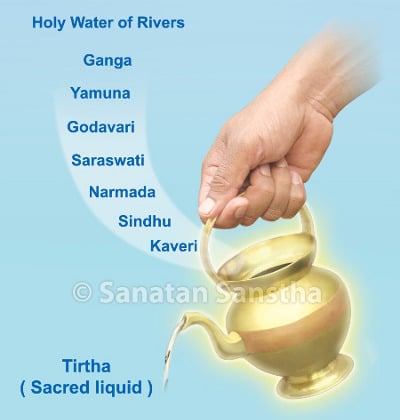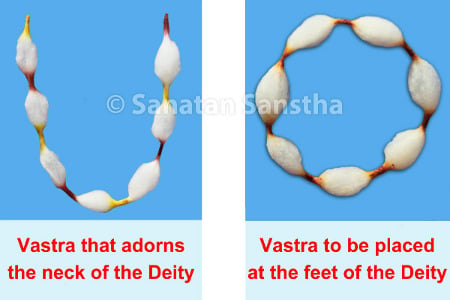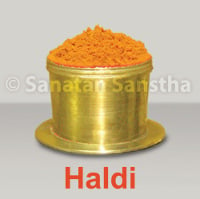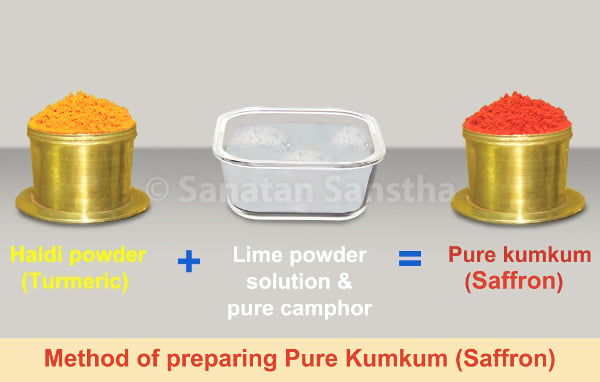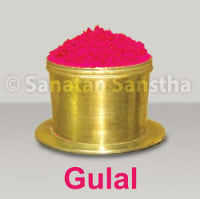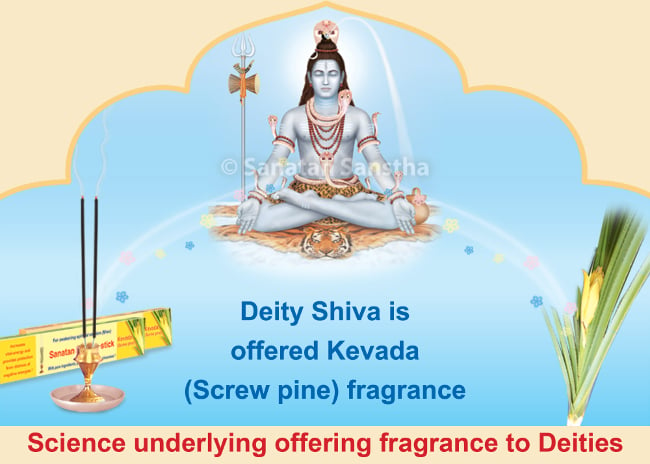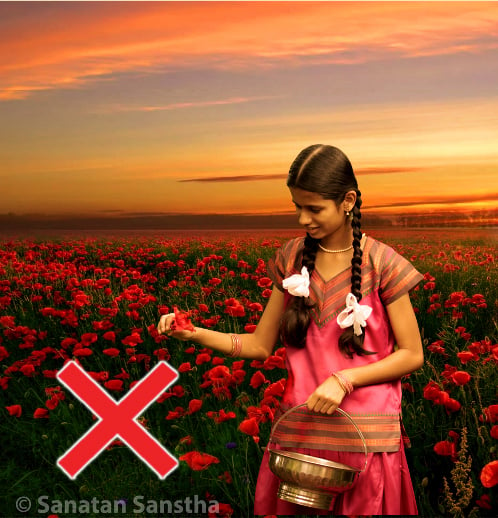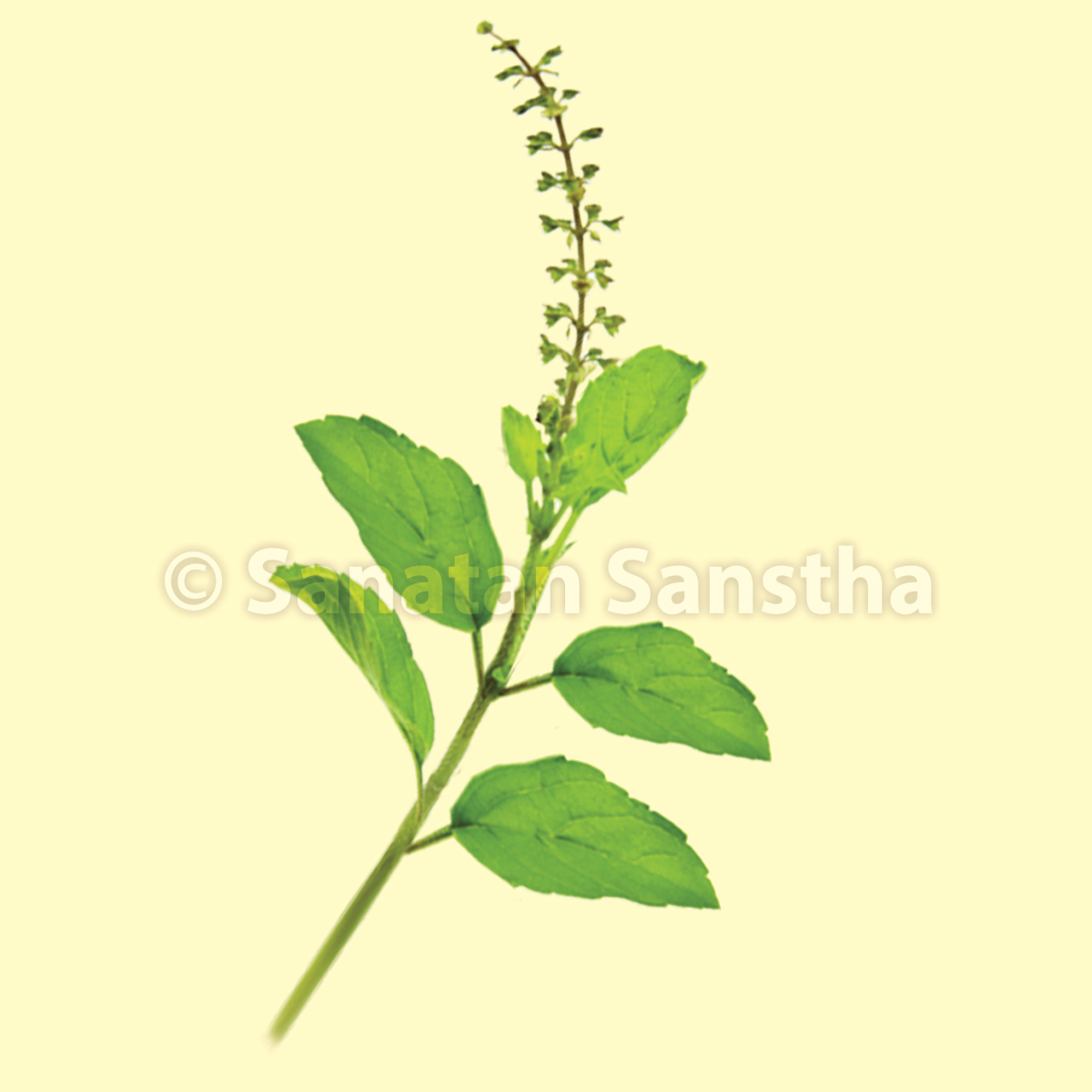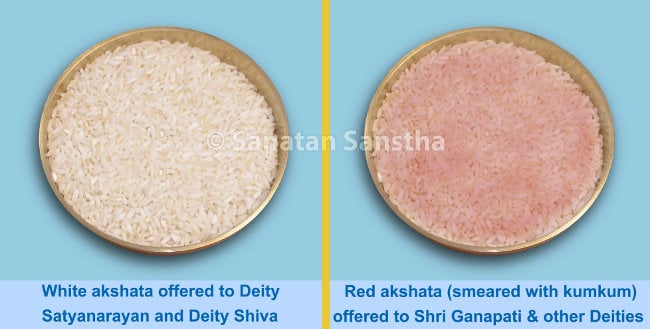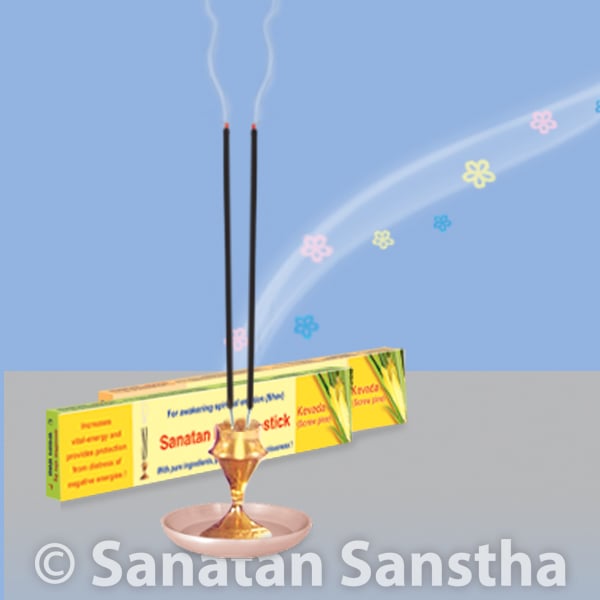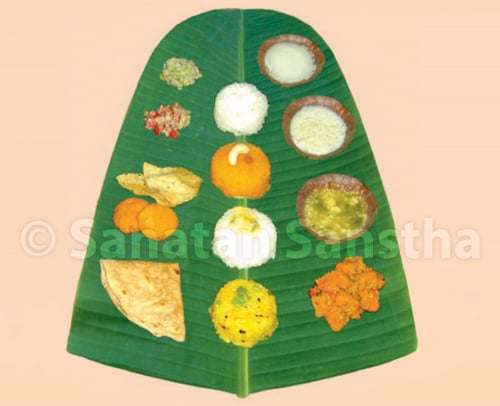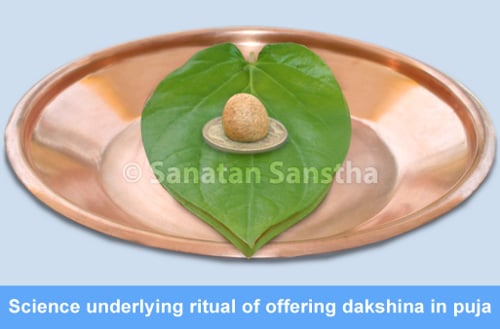Some religious rituals are incomplete without the help of other components, for example, specific substances (Puja Samagri) are necessary in ritualistic worship of God. These components aiding the religious rituals are an important link in seeking the grace of God through the medium of religious rituals. Understanding the spiritual importance of each of these components (Puja Samagri) enhances the bhav (Spiritual emotion) towards them, thereby making the religious ritual rich in bhav. With this objective in mind the spiritual importance and salient features of the components (Puja Samagri) like turmeric, vermilion, gandha (sandalwood paste), flowers, akshata, betel nut, coconut, Panchakhadya, incense sticks, camphor etc. used in ritualistic worship are mentioned in this article.
1. What are the various substances (Puja Samagri) used in ritualistic worship?
A. Water of the seven Holy Rivers:
The Holy Rivers Ganga, Godavari, Narmada, Kaveri, Krushna, Brahmaputra and Yamuna are considered the seven Holy Rivers. Water from all these seven rivers is collected in the ritualistic pot, which is used during ritualistic worship. ‘Water from these seven Holy Rivers has the ability to attract and transmit the frequencies of Saptadevtas (seven Superior Deities). India is known as the most sattva predominant place on earth because it is the only country through which all these seven rivers flow. Many yogis have undertaken penance on the banks of these rivers so as to acquire the Principles of the Saptadevtas in the Universe. This water from the ritualistic pot is used for performing the abhishek. The subtle sound frequencies from the ritualistic pot absorb the frequencies of the Saptadevtas in the water and effectively transmit them into the atmosphere. Since these subtle sound frequencies have a higher speed and expanse, the effectiveness of the frequencies of the Saptadevtas transmitted into the atmosphere through the water of the seven rivers remains in the environment for a longer period. Since these frequencies are transmitted with the help of the particles of the Absolute Water element in the water and the particles of the Absolute Ether element from the sound frequencies in the ritualistic pot, this water can be consumed as tirth (Holy water). By doing so with bhav and devotion, the Divine frequencies in this tirth activate the five vital energies in the form of gases that are in dormant state surrounding the navel, in the body of the devotee. With the help of these subtle gases these Divine frequencies spread all over the body of the devotee. As a result, purification of the vital energy body and vital energy sheath of the embodied soul occurs. Hence, consuming tirth gives the embodied soul sattva predominant satisfaction and its mind becomes Blissful and enthusiastic.
B. Cotton vastra
Why is milk or gandha used when making a vastra from cotton? : The cotton vastra represents the Sushumna nadi of the kundalini (Cosmic energy system) and the seven cotton beads in the vastra are associated with the seven centres of the kundalini system, in the body of the embodied soul. The cotton thread joining these beads is the link to the manifest Chaitanya (Divine consciousness) providing sattva predominant frequencies to the entire body. When the attributeless Chaitanya in the Absolute zero manifests as per the bhav of the embodied soul towards God, its colour is white and shining. In contrast the attributeless Chaitanya is like transparent water; it is however dormant in this state. The cotton beads and the thread joining them are the carriers of the manifest Chaitanya in the body. Milk is used to make the constrictions in this thread because the flow of manifest Chaitanya is like the flow of milk. When this Chaitanya is provided to these beads, these bead like centres of the kundalini in the body are activated and the embodied soul comes into a state of duality and on the strength of non-duality carries out the functions related to the physical body in the Universe. Use of gandha is preferable to milk when making the vastra. Due to the coating of gandha the frequencies of the Deities are activated faster and get attracted to the cotton vastra. By adorning the Deity’s neck with this sattva predominant vastra, the Deity assumes His ‘with attributes’ form faster and begins functioning for the embodied soul in a shorter time.
C. Janeu (Sacred thread)
What is the Science in offering the janeu to Deities?
Offering the janeu to Deities means binding the expanse of the brilliance of Deities in the rounds of the sacred thread and evoking them to function in duality. As the janeu is made of thread and is charged with energy of a mantra, the frequencies of sound emitted by it activate the attributeless Principle of God from the Universe. This then functions for the embodied soul as per its bhav towards God. The thread of janeu represents the silver link between God (non-duality) and the embodied soul (duality). Offering the janeu is an important process of interaction of duality and non-duality. Wearing this sacred thread after the ritualistic worship endows one with the sattva predominant Chaitanya of the Deity.
Turmeric being a tuber, the frequencies of earth in it are in far greater quantity than in stems growing above the surface of earth. Vermilion is prepared from turmeric. Since turmeric and vermilion are offered to Deities, the worshipper benefits from the frequencies of earth in them, as well as from the frequencies of Deities. Consequently, the sattva component in him is enhanced and his ability to tolerate raja-tama (distressing) frequencies also increases.
How to identify pure vermilion? : Constituents of pure vermilion are pure turmeric, diluted lime powder solution made in water and a small quantity of pure camphor. Though vermilion is made from turmeric, the odour of turmeric is entirely eliminated from it and a Divine scent takes its place. The odour of turmeric is evident only when it is sniffed. In contrast, the scent of pure vermilion is evident up to a certain distance. Pure vermilion has indigenous humidity and yet is completely dry. Its touch is cold like that of ice. Pure vermilion is blood red in colour. By applying this vermilion on the forehead, negative energies are prevented from entering the body through the midbrow region. In the past eras (Satyayug, Tretayug and Dwaparyug) pure vermilion was available. With the passing of the eras the sattva component in the vermilion has gradually waned. In the current times, pure vermilion is scarcely available.’
( To order pure vermilion, send an e-mail to – [email protected] )
E. Gulal
The Divine energy Principle in the Universe is attracted to the fragrant particles in the subtle air generated by the gulal. Also the dormant frequencies enriched with Chaitanya in the atmosphere become mobile because of the gulal. Thus the worshipper benefits from them.
‘When gandha is applied to the midbrow region of the Deity in the picture or the Idol, due to the qualities of the substance from which it is made, its subtle scent and its specific colour, the Surya nadi of the Deity is activated. Consequently, the Principle of the Deity is attracted to the photo or the Idol of the Deity in which they get activated. Amongst the different types of gandhs applied to Deities, ashtagandha and sandalwood gandha are the most sattva predominant.
G. Perfume
What is the Science in offering perfume to Deities? :
Fragrance and sound please the Deities. As the frequencies of fragrance are associated with the Absolute Earth element they give benefit of the Chaitanya at the physical body level to the embodied soul. Avoid offering perfume with a strong odour for the following reasons. The frequencies emitted by perfume with a strong odour attract only the ‘with attributes’ Principle of the Deity whereas frequencies emitted by a mild and pleasant perfume attract the attributeless Principle of the Deities in the Universe in a very short time and help the embodied soul to retain the benefit of the Chaitanya for longer time.
What fragrance perfume should be offered to which Deity?
| Deity | Fragrance of perfume that attracts the Principle of the Deity to a greater extent |
Deity | Fragrance of perfume that attracts the Principle of the Deity to a greater extent |
|---|---|---|---|
| 1. Shriram | Jai | 5. Shri Lakshmi | Gulab |
| 2. Hanuman | Chameli | 6. Shri Ganapati | Heena |
| 3. Shiva | Kevada | 7. Datta | Vala |
| 4. Shri Durga | Mogra | 8. Shrikrushna | Chandan |
Note 1 : Offer nine flowers to the energy forms of Shri Durgadevi (Primal energy). The number ‘9’ indicates the actual function in duality of Sri Durgadevi through Her other forms. Hence, it is appropriate to offer nine flowers to Her forms – Goddess’ Mahakali, Saraswati, Mahalakshmi and Lakshmi.
Why should flower buds not be plucked after sunset? : ‘At Brahmamuhurt, that is between 4 and 6 a.m., the pavitrake of Deities descend to the earth in greater proportions. The pavitrake of Deities are attracted only to those flowers which have the potential to absorb them. The radiance of the Sun causes disintegration of the raja–tama particles in the atmosphere. Hence, the period before sunset is more sattva predominant than after it. After sunset the raja-tama predominance in the atmosphere increases. Consequently, the atmosphere gets polluted due to increased movement of negative energies. That is why, after sunset the flower buds get contaminated with raja-tama particles. This reduces their ability to attract pavitrake of Deities. For this reason the flower buds are usually not plucked after sunset.
Why should dried or worm infested leaves, flowers and fruits not be used in the ritualistic worship of God?
-
‘Always offer the best to Deities. They subtly partake what is offered to them and then pleased with the offering, they bless the devotee.
-
The pranvayu in the leaves, flowers and fruits is responsible for the absorption of sattva frequencies and the specific Deity Principle from the Universe. The dhananjayvayu from these substances transmits these frequencies and the Principle. Fresh leaves, flowers and fruits have over 70% pranvayu and dhananjayvayu in them. Thus leaves, flowers and fruits are storehouses of the sattvikta and frequencies of the Principle. When these substances are affected by raja-tama components at the subtle level, they get spoilt at the gross level. Consequently, their capacity to absorb the sattva frequencies and frequencies of the Principle of the Deity is lowered. No one benefits from use of such substances. Deities partake the offerings subtly and are not pleased with such offerings and therefore do not bless the devotee.’
I. Patri (Specific leaves offered during worship)
Which and how many patri should be offered to which Deity? : It is beneficial to offer the patri of those flower plants which are favourite of the Deity. Patri is related to the colour particles, whereas the flowers are related to the fragrant particles. The difference between the colour particles and fragrant particles is given in the following table.
| Colour particles | Fragrant particles | |
|---|---|---|
| 1. Characteristic of the frequencies emitted | Related to the halo of the Deity | Carrier of light |
| 2. Function | To help immediately manifest the sagun form of the Deity | To invoke the Deity to function |
It is necessary to offer five part patri to the Deity. This kind of patri denotes the five Cosmic elements, that are – the Absolute Earth, Water, Fire, Air and Ether. By offering five part patri to the Deity, it manifests with the help of the five Cosmic elements and through the medium of light in a form as required by the embodied soul. The frequencies emitted by this form are delivered to the embodied soul through the medium of the frequencies emitted by the flowers. That is why, by offering both patri and flowers the embodied soul derives maximum benefit from the ‘with attributes’ as well as the ‘attributeless’ Principle of God, that is, of the radiant Principle. Hence, inclusion of patri and flowers in the ritualistic worship is a must.
J. The Holy basil
Why are the leaves of the Holy basil and bel (Aegle marmelos tree) always pure? : The Holy basil originally has 50% Vishnu Principle and the bel plant has 70% Shiva Principle. When they are used in the ritualistic worship the Divine Principle in them increases by 20%. The raja-tama in the environment affects every object. The enhanced 20% Divine Principle is used in combating the raja-tama in the atmosphere. The grossly apparent effect of this is that the Holy basil or bel leaves appear dried up or singed. Nonetheless they continue emitting the Divine Principle originally present in them. Hence, the Holy basil and bel leaves are always pure. As the Holy basil emits the Deity Principle constantly, it makes the surrounding environment sacred. That is why a house with a tulasivrundavan (A small rectangular structure in which the Holy basil plant is grown) is considered sacred.
K. Akshata
Akshata has the ability to attract the frequencies of the five Deities in the Universe (Ganapati, Shri Durgadevi, Shiva, Shri Ram and Shri Krushna), to activate them, make them functional and to transmit them with the help of the Absolute Earth and Absolute Water elements. Hence, akshata is sprinkled on every component of the ritualistic worship, so also on the Idol of Deity after the panchopachar or Shodashopachar pūja and after activating the divinity in all of them, they are invoked to become functional. In the absence of any substance in a panchopchar pūja, akshata is used as a substitute. Akshata is a medium that encompasses all the Deity Principles and hence is an important all-encompassing medium in ritualistic worship. Because of the energy in the Deity, when akshata is offered to them, benevolent energy and vibrations develops in the akshata. If a string of a sitar, among a pair of similar frequency sitars, is sounded then the same sound is emitted from the other sitars too. Similarly, once frequencies develop in the akshata due to energy of the Deity, same frequencies develop in the stock of rice in the house. This energised rice can then be consumed throughout the year as prasad.
L. Betel leaf
-
Similarity of characteristics with the subtle frequencies from the region of Brahma (God in His aspect as the Creator of the universe) : The subtle air frequencies created due to the friction between the colour particles in the betel leaf match the subtle air frequencies from the region of Brahma. The sattva frequencies emitted by the Idol of the Deity are absorbed through the stalk of the betel leaf. Consequently, the colour particles in the leaf are set into motion. As an effect of this motion, subtle air is created which is transferred to the tip of the leaf by the particles related to the Absolute Water element in the leaf and then transmitted to the atmosphere. These air frequencies have the ability to activate the frequencies of Will of the required Deity functional in the Universe. Because of these frequencies, the mental sheath of the embodied soul gets purified and it derives desired benefit.
-
The medium connecting the earth and the region of Brahma : The creeper of betel leaves is called nagvel (serpentine creeper). The nagvel has the ability to attract frequencies of the earth and the Brahma region and is considered as a link connecting the two regions. Since it is sattva predominant, if a menstruating woman plucks betel leaves, then the creeper dries up. This is because when a menstruating woman comes in the environment of a nagvel, due to the effect of the friction between the raja-tama frequencies emitted by her body, the sattva predominant particles in the environment disintegrate. Hence, the creeper shrivels or black spots appear on its leaves.
M. Betel nut
There is a perfect blend of particles of the Absolute Earth and Absolute Water elements in the betel nut. The Earth element particles from the betel nut bind the frequencies of Chaitanya emanating from the Deity. Then the particles of Chaitanya in these frequencies of Chaitanya are activated by the particles of the Absolute Water element in it. Thus the betel nut serves as the chief medium for the exchange of frequencies between a Deity and the embodied soul.’
N. Coconut
-
Why is the coconut called ‘Sriphal’, the most auspicious fruit? : The coconut has the capacity to attract the frequencies of the five Deities namely, Shiva, Shri Durgadevi, Ganapati, Shriram and Shrikrushna and transmit them as required. Hence, coconut is considered as the most auspicious fruit – ‘Sriphal’, the most sattva component bestowing fruit’.
-
Relief from distress of negative energies due to coconut : Coconut has the ability to attract benevolent (Divine) as well as malevolent (distressing) frequencies. Hence, if a person is affected by negative energies, a coconut is used to perform the ritual of removing ‘drishta’ (evil-eye) to relieve his distress. The sound when breaking a coconut is akin to the destroyer mantra ‘Aum phat’. Because of the sound, the negative energies run away.
O. Panchkhadya, five fruits and a piece of solid turmeric
There is great importance to the ‘with attributes’ as well as the attributeless levels in every ritualistic worship. The five Cosmic elements are required for the manifestation of this form. They are present in the core of the Universe in a dormant form. In the Panchopachar pūja, devotion unto God at the level of the Absolute Earth, Water, Fire, Air and Ether elements is essential. Only then does one get complete benefit of the ritualistic worship and there is generation of energy that bestows Chaitanya in him. For the generation of this energy, flowers and leaves (the Absolute Earth element), turmeric (the Absolute Earth element), five fruits (the Absolute Water element), perfume (the Absolute Fire element), Panchkhadya incense sticks (the Absolute Air element) and coconut (that which generates sound, the Absolute Ether element) are all required. Due to the emission of frequencies of fragrance through the medium of the flowers, the form of the Deity in the Universe is attracted to the embodied soul. Through the medium of the colour frequencies transmitted through the patri (Leaves) it attains a body form for the benefit of the embodied soul. By offering the five fruits, meaning, due to the emission of the frequencies of sweet juice (the Absolute Water element), as the secretion of the internal fluids in the embodied soul is facilitated, its bhav is awakened. Due to the awakened bhav the seven centres in the embodied soul enter an activated state and imbibe the Chaitanya of the ‘with attributes’ manifest form in the Universe. The frequencies associated with the Absolute Fire element emitted through the medium of the perfume activate the Energy of Soul and the energy generated by the sound of the coconut purifies the atmosphere. The other components in the Panchkhadya – almonds, walnut and dried dates all have seeds. Hence, the dormant air in their covering is a good carrier of the subtle Chaitanya emitted by the Deity. Thus the Chaitanya of the Deity activated by offering of these components percolates deep into the body of the embodied soul through the medium of the Absolute Air element. Because turmeric is a tuber and associated with the frequencies of earth, it bestows grossness to the frequencies of Chaitanya that are activated at the level of five Principles and thus makes them eligible to be imbibed by the embodied soul. With the help of these components, even in the absence of the requisite spiritual level of the embodied soul, the Principle of the Deity functions for it in a short time.
P. The wick in the lamp
The science underlying rolling two wicks into one and placing them in the lamp.
-
Two wicks : A symbol of duality
-
The common tip formed by rolling the two wicks : The single wick formed by rolling the two wicks and the common tip is symbolic of the embodied soul’s journey towards non-duality.
-
The flame at the common tip of the two wicks : The radiance manifested and stationary at the common tip formed by the union of the two wicks is a symbol of the embodied soul’s non-duality.
Q. Incense stick
The Deities contain the five Cosmic elements. Of these, the Absolute Earth element emits fragrance. As this fragrance is very subtle an average embodied soul is unable to imbibe it. The incense sticks have the ability to imbibe the subtle fragrance emitted by the Deities. Hence, when incense sticks are lit, the subtle fragrance attracted from the Deities (in the incense sticks) is also emitted along with its own fragrance. For example, when the incense stick with sandalwood fragrance is lit, the subtle sandalwood fragrance attracted from the Deities is also emitted along with the fragrance of the incense stick. Another characteristic of the incense sticks is that, they imbibe and emit the Principle of the required Deities in the form of fragrance, for example some seekers have the spiritual experience of subtle fragrance of sandalwood from the incense stick of kevada.
Frankincense has a strong fragrance. This functions as the destroyer form. The Principle of the specific Deity gets activated through the fragrance of the frankincense. It acquires the form of the subtle weapons and combats the raja-tama in the environment. Consequently, the sattva component in the environment increases. Naturally the environment and premises are purified. The environment imbibes the subtle-most frequencies emitted by the Deities to a large extent and the distress due to negative energies, if any, is reduced by 30%. Thus, obstacles posed by negative energies are reduced. Hence, frankincense is lit before ritualistic worship and arati.
Frankincense completely eliminates the distressing frequencies in the atmosphere around the site of ritualistic worship and facilitates removal of the obstacle in the transmission of sattva predominant Chaitanya by the Deity towards the embodied soul. This Chaitanya is imbibed by the embodied soul in a shorter time.
S. Camphor
The odour of the subtle air generated by burning camphor has the ability to attract messengers of Deity Shiva to a greater extent. These messengers keep the inferior negative energies in the premises under control. Their presence also helps in obtaining the blessings of Deities of a place and premises. The atmosphere created by the subtle fragrant frequencies emitted by the odour of camphor is similar to the atmosphere of Deity Shiva’s region. The atmosphere enriched with these fragrant frequencies attracts frequencies of the Shiva Principle from the Universe, which in turn control the activity of the negative energies in the premises. As the hindrance of distressing frequencies to the sattva frequencies transmitted by the ritualistic worship is prevented, the environment becomes pure and enriched with Chaitanya.
Camphor has fragrance, that is, the Absolute Earth element. When camphor is ignited, the Absolute Fire element in it manifests. The Shiva Principle in it through the medium of fragrance and fire is activated to a large extent. Consequently, the sattva predominance in the environment increases. Due to the fragrance of camphor, the Shiva Principle enters the body through the breath and destroys the black energy and black air in the respiratory tract. The fragrance of camphor also helps in alleviating the disorders of respiration.
T. Offering Naivedya
The food items to be offered to each Deity is predetermined. It is said that every Deity has some favourite food item which is offered as Naivedya to Him / Her, for example, kheer or shira for Vishnu, modak for Ganapati, payas for Goddess. The specific food item offered to a specific Deity attracts more frequencies of that Deity. When this Naivedya is partaken as prasad, we benefit from the energy of that Deity in it.
U. Ritual of offering dakshina
What is the Science in the ritual of offering dakshina in ritualistic worship ?
By offering dakshina, a value of sacrifice develops in the embodied soul. From sacrifice, detachment develops and this in turn gives rise to vairagya (ascetic-like detachment). Once Vairagya develops, the embodied soul remains in constant communion with God, even though in the Maya (the Great Illusion). The foundation of Hinduism is in sacrifice. That is why learning to sacrifice (by offering money), is the first step in Karmakand form of spiritual practice. Hence, the ritual of dakshina has inordinate importance. Dakshina is looked upon as Divine energy, meaning Goddess Lakshmi, and worshipped. Hence, every act performed is complemented with Divine energy and it becomes an act without doership (akarma-karma). Consequently, its fruit does not create a give and take account; but it is added in the merits (punya-karma).
Why is the money in the ritual of offering dakshina, placed on two betel leaves along with betel nut or coconut ?
The money in the ritual of offering dakshina is never given by itself. It is important to place it along with betel nut or coconut on the betel leaves. In this process, the dakshina functions in the form of Divine energy, whereas the betel nut or coconut functions in the form of Shiva. In a way Shiva-Shakti are offered a place for their mission, that is, in a way a seat is offered to them. The betel leaves are always placed in pairs, because two signifies duality in the mission of ShivaShakti. In this way, the worshipper offers a seat to Shiva-Shakti in the form of betel nut or coconut and dakshina on the betel leaves and prays that they function in ‘with attribute’ form.
V. Bhasma, cowdung and water
-
Bhasma : This is related to the Fire element. In Hindu Dharma, bhasma is considered to be a symbol of detachment and is therefore sacred.
-
Cowdung : This is related to the Earth and Water elements. In Hindu Dharma, the cow is considered very Holy, because it can absorb the frequencies of all Deities and bestow divinity.
-
Water : This is considered to be a symbol of the stream of Nirgun (Non-materialised) Chaitanya. Since water has the capacity to imbibe raja, tama and sattva frequencies, it is thought to be a medium of destroying all sins.
W. Rangoli (Holy designs made on the ground from white crushed powder)
The importance of drawing rangoli and applying turmeric and vermilion around a wooden platform or altar : Drawing a rangoli in a sattvik pattern around a wooden platform or altar before commencing any ritualistic worship helps form a protective sheath around them, of rapidly moving frequencies emanating from that pattern. The earth frequencies are attracted towards the frequencies emanating from the rangoli and are conjoined within its pattern. Through the said pattern, essential sattvik frequencies are projected towards the embodied soul, which also help in creating a subtle sheath on the floor and protecting the embodied soul from those projected by the black energies from hell or the premise. Due to the different patterns of the rangoli, the accumulated frequencies of different Deities scare the black energies away. The frequencies of superior Deities in the Universe get easily attracted towards the colour particles related to the Tej (Absolute Fire Principle) Principle projected from the turmeric-vermilion offered at the centre of the rangoli. As a result, the capacity to act, the speed and the outcome of the frequencies projected from the rangoli is enhanced. Hence, to avoid any possible obstruction from black energies, rangoli is drawn in front of a house, at the place of worship or around a platform at the time of any ritual.
X. Panchgavya
The Panchgavya creates a protective sheath around the seeker and this restrains negative energies from posing obstacles in spiritual practice : With the help of the five Cosmic elements, the Panchagavya attracts frequencies of superior and inferior Deities; it forms a protective sheath (which is composed of upward and downward mobile frequencies of Chaitanya on earth and in the atmosphere). This ensures that the worshipper gets maximum benefit of the Chaitanya emitted from the rituals and restrains the negative energies from posing obstacles in this process of emission of Chaitanya during the ritualistic worship. Since a seeker in the initial stages has less bhav for God, the Panchagavya serves as a medium of ensuring benefits, by being conducive to his protection.
2. How should the puja samagri placed in Puja Thali (ritualistic platter) be arranged?
Before actually commencing a ritualistic worship it important to arrange the implements and other substances that is part of ritualistic worship. It is appropriate to arrange them based the level of the five Cosmic elements from the viewpoint of the science of Spirituality. Such an arrangement balances and coordinates five cosmic elements that are active in the Universe helping the embodied soul to derive maximum benefit of the ‘with attribute and attributeless frequencies emitted by the Deity. This arrangement indicates the journey of the embodied soul from Maya to Brahman that is associated with the five Absolute. An important component of the first level is the Puja Thali. The arrangement of the puja samagri in the Puja Thali is explained ahead.
-
‘In the Puja Thali place turmeric and vermilion to the right side and bukka, gulal and shendur (Black, pink and orange coloured powders used in ritualistic worship which attract the Deity’s Principle) to the left side of the embodied soul.
-
The perfume bottle, gandha , flowers, durva and patri should be placed at the forefront in the platter because the subtle frequencies of the Deities are activated by the fragrance particles in the perfume, gandha , flowers and also by the colour particles in the durva and patri.
-
The betel leaves, betel nut and dakshina are should be placed at the other end of the platter Puja Thali because they are an effective medium of transmission of frequencies of the Deities.
-
In the centre, place the all-encompassing akshata. As akshata becomes the central portion in the Puja Thali, the frequencies of the five superior Deities namely Shiva, Shri Durgadevi, Shriram, Shrikrushna and Ganapati are attracted to them and are then transmitted as per the requirement to the other components like vermilion, turmeric etc. placed around them in a circular manner.’
Reference : Sanatan Sanstha’s Holy Text on ‘What is the Importance of the Substances used in Ritualistic Worship?‘ and ‘Science underlying worship with five and sixteen substances’

